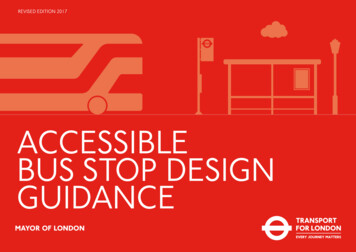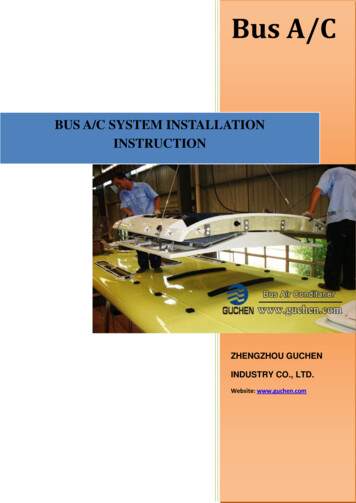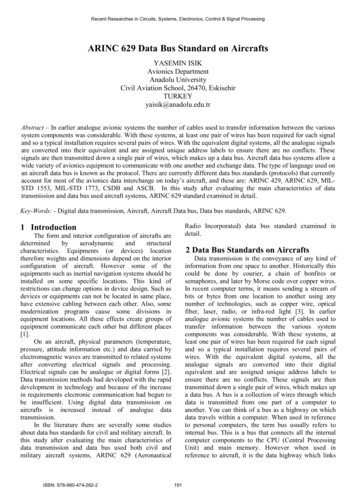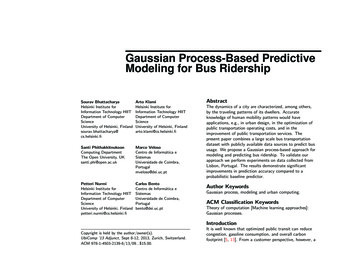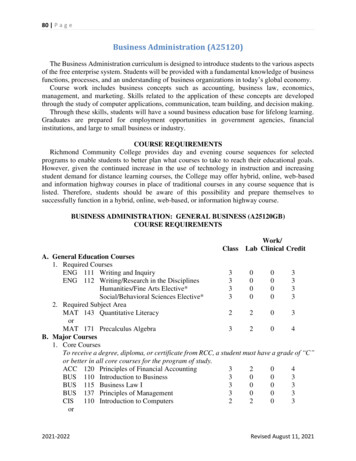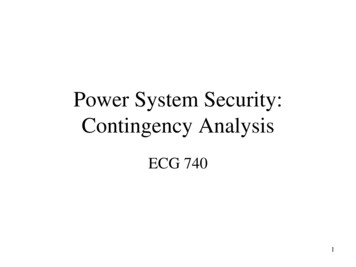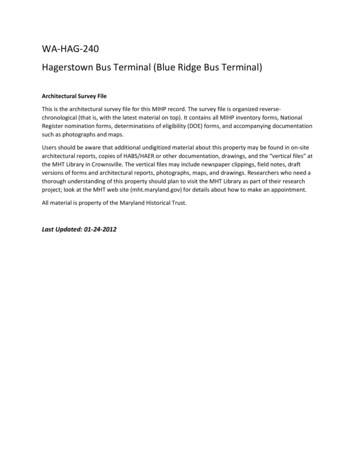
Transcription
WA-HAG-240Hagerstown Bus Terminal (Blue Ridge Bus Terminal)Architectural Survey FileThis is the architectural survey file for this MIHP record. The survey file is organized reversechronological (that is, with the latest material on top). It contains all MIHP inventory forms, NationalRegister nomination forms, determinations of eligibility (DOE) forms, and accompanying documentationsuch as photographs and maps.Users should be aware that additional undigitized material about this property may be found in on-sitearchitectural reports, copies of HABS/HAER or other documentation, drawings, and the “vertical files” atthe MHT Library in Crownsville. The vertical files may include newspaper clippings, field notes, draftversions of forms and architectural reports, photographs, maps, and drawings. Researchers who need athorough understanding of this property should plan to visit the MHT Library as part of their researchproject; look at the MHT web site (mht.maryland.gov) for details about how to make an appointment.All material is property of the Maryland Historical Trust.Last Updated: 01-24-2012
Maryland Historical TrustMaryland Inventory ofHistoric Properties Form1. Name of PropertyInventory No. W A - H A G - 2 4 0(indicate preferred name)historicHagerstown Bus TerminalotherBlue Ridge Bus Terminal2. Locationstreet and number29-33 East Antietam Streetnot for publicationcity, townHagerstownvicinitycountyWashington3. Owner of Property(give names and mailing addresses of all owners)nameOlajide Jones Boluwarin/ Washington County Commissionersstreet and number101 Vi Cypress Street/ Washington County Court Housetelephonecity, townHagerstownzip codestateMD217424. Location of Legal Descriptioncourthouse, registry of deeds, etc. Washington County Court Housecity, townHagerstowntax maplibertax parcel2308 folio 315tax ID number5. Primary Location of Additional DataContributing Resource in National Register DistrictContributing Resource in Local Historic DistrictDetermined Eligible for the National Register/Maryland RegisterDetermined Ineligible for the National Register/Maryland RegisterRecorded by HABS/HAERHistoric Structure Report or Research Report at MHTOther:6. ClassificationCategorydistrictX teX bothCurrent FunctionagricultureX rnmenthealth ialtransportationwork in progressunknownvacant/not in useother:Resource ucturesobjectsTotalNumber of Contributing Resourcespreviously listed in the Inventory
7. DescriptionInventory No. W A - H A G - 2 4 edPrepare both a one paragraph summary and a comprehensive description of the resource and its various elements as itexists today.Built in 1947, the Hagerstown Bus Station occupies a lot in the first block of East Antietam Street just east of Cramer Alley. Onestory in height and Modern in design it is distinctive among the neighboring buildings, most of which are two and three story brickresidential or combined residential and commercial buildings dating from the late 19* century. The large 1964 Washington CountyLibrary building dominates the southeast corner of East Antietam and South Potomac Streets just west of the bus station. The busstation, constructed for the Blue Ridge Transportation Company is a concrete block building with a stepped parapet front covered withwhite and blue Carrara glass (structural pigmented glass) panels. A large central vertical pylon carried the name of the bus company.Flanking the recessed central entrance are large plate glass windows. The side and rear walls are exposed painted concrete block. Adriveway along the east side of the building provides access to the covered platform where passengers boarded and disembarked fromthe busses. Busses exited onto Cramer Alley and Antietam Street.The front section of the bus station is one story in height with a low sloped flat roof with parapets on the north, east and west sides.The rear section is taller with high glass block windows lighting the interior waiting area. This higher section has a very low pitchedgable roof with its ridge running east-west, and stepped parapets covered with tiled coping at each end. Lower one story wings extendfrom the higher section on the east, south and west sides. A deep shed canopy extends along the south elevation over a concreteplatform. Running perpendicular to the rear canopy is a long covered platform leading to the rear or south of the property. Along theplatform are stalls to accommodate busses, with space for up to 13 busses at the time it was constructed. The covered platforms aresupported by round metal columns with wooden cross brackets. The columns support horizontal plates bolted together to run thelength of the platform. The rafters and collars of the roof system are exposed.The attached Sanborn Insurance Map from 1951 shows the bus station foot print in completed form.
8. SignificancePeriodAreas of SignificanceXagriculturearcheologyX architectureartcommercecommunicationscommunity 0-19992000-Specific dates1947Construction dates1947Inventory No.WA-HAG-240Check and justify creationethnic heritageexploration/settlementperforming tics/governmentlandscape architecturereligionlawscienceliteraturesocial historymaritime historyX ation for:National RegisterXMaryland Registernot evaluatedPrepare a one-paragraph summary statement of significance addressing applicable criteria, followed by a narrative discussion of thehistory of the resource and its context. (For compliance projects, complete evaluation on a DOE Form - see manual.)The 1947 former Blue Ridge Transportation Company bus station is significant for its highly intact Modern architectural design andfor its role in the regional transportation history, which led to Hagerstown becoming known as the "Hub City" for its importance inrail and road travel. The building retains most of its character defining features and appears essentially as built and thus has a highlevel of integrity of location, setting, design, materials, workmanship, feeling and association. It is listed in the National Register ofHistoric Places as a contributing property in the Hagerstown Historic District (WA-HAG-0158).The Blue Ridge Line was providing bus service to Hagerstown by the 1920s. It began in the 1890s as the Blue Ridge Trolley whichestablished the Potomac Edison Electric Company to provide electrical power for the interurban electric railway. The Potomac EdisonCompany eventually owned the Blue Ridge Transportation Company. According to the Western Maryland Regional Library's website (www.whilbr.org), "the Potomac Edison News of 1929 announced that the third bus terminal in the east was opened inHagerstown, following the lead of New York and Baltimore. The terminal for buses starting in 1929 and in use until the end of WorldWar II was in the basement of the Alexander Hotel on the Square - the entrance was off East Washington Street."The station in the Alexander Hotel served until the present building was opened in 1947. The Potomac Edison employees' newsletterfrom February 1947 noted, "The new location of the Blue Ridge bus terminal in Hagerstown features a bus stop and passengeraccommodation arrangement not present in this form at any other terminal along BR routes. The buses pull into numbered stallsarranged at an angle and load or discharge passengers at a platform which is covered. This method of handling traffic and buses hasproved highly satisfactory to the public and to Blue Ridge at Hagerstown" (Potomac Edison News. February, 1947, quoted on theWestern Maryland Regional Library web site, www.whilbr.org).In the 1960s the bus station became the Greyhound terminal, until the terminal was moved outside of downtown Hagerstown in the1980s. William Arrasmith was the architect for Greyhound Lines Bus Company from 1937-1960. He designed at least 50 terminalsand facilities for Greyhound. In 1946 Arrasmith proposed a terminal for Hagerstown, which became the prototype for his Post WorldWar II bus station designs. That Hagerstown terminal was never constructed, but a rendering of it is pictured in The Streamline EraGreyhound Terminal: The Architecture ofW.S. Arrasmith by Frank E. Wrenick (2007) p. 153. The proposed terminal was muchlarger than the existing Hagerstown terminal with two full stories and the L-shaped pylon that became Greyhound's trademark forpost-war stations.The Hagerstown Bus Station with its original Cararra Glass facade, windows, doors and platforms provides an excellent of Modernarchitecture of the streamline era, and evokes Hagerstown's history as a major transportation center.Following are historic views of the bus station courtesy of the Western Maryland Regional Library, acknowledging MichaelGuessford, the Enoch Pratt Library and the Western Maryland Room of the Washington County Library.
Maryland Historical TrustMaryland Inventory ofHistoric Properties FormInventory No. WA-HAG-240NameContinuation SheetNumber 8 Page 1wmmmmmmmmmmmmmmmmmmmmmimmmmsBmmm mAnnouncingBLUE RIDGE BUSES WILL OPERATE FROMTHEIR NEW TERMINAL31 East Antietam StreetHAGERSTOWN, Md. (Along "LOOP" City But Route)PHONE 1820LARGE COMFORTABLE WAITING ROOMUNDER-COVER, INDIVIDUAL BUS LOADINGPLATFORMSMODERN, CONVENIENT REST ROOMSRESTAURANTDRUG STORENEWS AND CIGAR STANDPotomac Motor Line», Will Continue to Operate From New TerminalThe L. & L. Motor Line* Will Operate From Thii Terminal
Maryland Historical TrustMaryland Inventory ofHistoric Properties FormInventory No. WA-HAG-240NameContinuation SheetNumber 8 Page 2HAGERSTOWNThe new location of the Blue Ridge bus terminal in Hagj erstown feature* a bus stop and passenger accommodation ar rangement not present in this form at any other terminal along\ BR routes. As may be seen, the buacs pull into numbered stallsBUSTERMINALarranged at an angle and load or discharge passengers at aplatform which is covered. This method of handling trafficand buses has proved highly satisfactory to the public and toBlue Ridge at Hagertttown.Waiting room.
Maryland Historical TrustMaryland Inventory ofHistoric Properties FormNameContinuation SheetNumber 8 Page 3Inventory No. WA-HAG-240
Maryland Historical TrustMaryland Inventory ofHistoric Properties FormNameContinuation SheetNumber 8 Page 4View North from end of platform toward terminal building.inventory No.WA-HAG-240
Maryland Historical TrustMaryland Inventory ofHistoric Properties FormNameContinuation SheetNumber 8 Page 5View north from end of covered platform to terminal building.Inventory No.WA-HAG-240
Maryland Historical TrustMaryland Inventory ofHistoric Properties FormInventory No. WA-HAG-240NameContinuation SheetNumber 8 Page 61964 View of Washington County Library under construction, with the bus station in the background.
9. Major Bibliographical Referencesinventory NO.WA-HAG-240Western Maryland Regional Library ("www.whilbr.org) "Hagerstown Bus Terminals"Wrenick, Frank E., The Streamline Era Greyhound Terminal: The Architecture ofW.S. Arrasmith Jefferson, NC:McFarland &Company, 200610. Geographical DataAcreage of surveyed propertyAcreage of historical settingQuadrangle nameApproximately % acreApproximately V* acreHagerstownQuadrangle scale: 1:24,000Verbal boundary description and justificationThis parcel, recently divided in two with separate ownership is the property historically associated with the Blue Ridge Lines BusStation. It is shown more fully in the attached Sanborn Insurance Map of 1951.11. Form Prepared byname/titlePaula S. Reed, PhDorganizationPaula S. Reed and Associates, Inc.date1/26/10street & numberOne West Franklin Street, Suite 300telephone301-739-2070city or townHagerstownstateMDThe Maryland Inventory of Historic Properties was officially created by an Act of the Maryland Legislatureto be found in the Annotated Code of Maryland, Article 41, Section 181 KA,1974 supplement.The survey and inventory are being prepared for information and record purposes onlyand do not constitute any infringement of individual property rights.return to:Maryland Historical TrustMaryland Department of Planning100 Community PlaceCrownsville, MD 21032-2023410-514-7600
WA-HAG-240
The Blue Ridge Line was providing bus service to Hagerstown by the 1920s. It began in the 1890s as the Blue Ridge Trolley which established the Potomac Edison Electric Company to provide electrical power for the interurban electric railway. The Potomac Edison Company eventually owned the Blue Ridge Transportation Company.

